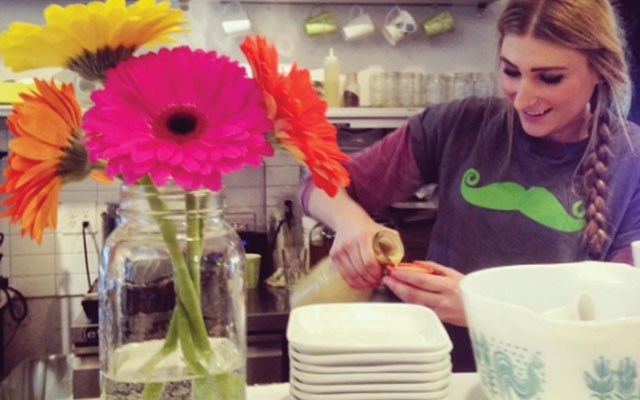There's the gentrification of cities and towns, even resorts like Whistler. And then there's the genderization of food. OK, that's a mouthful, so let's just call it the gendering of food and see where that gets us.
Ultimately, not very far.
"American ideas about food are inextricable from American attitudes about gender difference," writes Jennifer Jensen Wallach in her fascinating book, How America Eats: A Social History of U.S. Food and Culture. Given we are "children of a common mother," as the huge, white memorial describes Canada and the U.S. at the Peace Arch border crossing, we can safely substitute "Canadian" or even "British" for "American" in the above.
And so it is that despite decades of efforts to undo gender biases, we still see some amazingly traditional differences, especially around food, as these admittedly unscientific but interesting anecdotes from around Whistler tell us.
"The main thing is that guys do prefer meat more than women do," says Alex Powell, store manager for Olives Community Market, known for its organics. "Typically, in our salad bar if we don't have some meat protein out there like chicken or pulled pork, it will be a guy who says something, not a girl. And that's even if we already have a veggie protein, like quinoa."
Not to generalize (remember, this is anecdotal), but Alex wonders if it's because women are more educated about protein in vegetables and grains "because they care a little bit more about that kind of stuff." Or maybe it's because women are applying their predominant role in the domestic food scene to instigate change. Either way, don't kid yourself. Gender stereotypes are still aplenty in the food world.
"(Packaged food) is marketed a lot more towards women because a lot more women than men do grocery shopping," Alex says. "Usually it's women with much fuller baskets. The guys are coming in for just one or two things... and usually they're coming in with a list that their wife gave them, like, where do I find this stuff?
"It's not the first time that stereotype has been noticed."
At Alpine Café and Catering at the other end of the valley, owner/manger Martini Bart sees similar trends as he peers through the kitchen window to the counter where we customers order.
"On the women's side it's definitely lighter meals — everything's lighter. Everybody will tell you we sell a lot more salads to the girls. And the big burgers with bacon and cheese all over them are ordered by hefty guys," he says.
"The girls go after veggies more than the boys. I can't say all of them, it's just more are vegetarian, just like the staff working here. I've got one vegetarian guy and I've got, like, six vegetarian girls."
Of course, like all generalizations, these aren't 100-per-cent watertight, "... because I know we have a lot of beer-drinking, burger-eating girls here, too," says Martini.
But these gender-trenders happen with catering, too. At mountain bike camps, for instance, it's more egg salad, tuna salad and veggie sandwiches or wraps for the women versus mélange a trois — triple meat — sandwiches and heavy on Montreal beef for the men.
All of which made me wonder, do men and women really need different food? Or have we just been culturally cued?
For instance, a study by Cornell University's Food & Brand Lab concluded that men eat more food when they eat with women versus other men. At an all-you-can-eat pizza bar, men ate 92 per cent more when they were with a woman! It wasn't a nutrition thing. This is eating to impress a date, concluded the study.
But it sure isn't healthy, and award-winning Canadian author and food writer David Sax, agrees.
"Dude food is killing men" is the nub of his recent article in New York Magazine and an interview on CBC's Q.
"...Each day men are assaulted by food advertising urging them to eat like 'real' men. Eat a Manwich, a manly portion of Chunky soup, a KFC Double Down sandwich, and be sure to wash it down with a Gatorade," Sax writes in the NYM piece.
But, he notes, there's a huge disconnect between the way "real men" eat, and the way they're supposed to eat. "In the wild," he writes, "men eat an astounding variety of foods, including vegetables, fruits, and even fish."
Bottom line: not only are the culturally engendered biases for giant, meat-heavy portions for men really bad for their health, there's no nutritional basis for it.
Grant Achatz, molecular gastronomist and James Beard Foundation award winner, has a similar take. In a Guardian article, he says, "Dig into periods of time or age, geographical location, ethnicity and urban versus rural areas and you will find a separation in cooking familiarity and perhaps skill," he says. "But that has more to do with society's control over gender in general than the genetic makeup of people."
But maybe, just maybe, there's a glimmer of hope we're finally breaking through these gender biases. And, ironically, it just might be around healthy eating.
At The Green Moustache in the village or in Function, where "organic" and "vegetarian" are bywords, manager Emma Schlosser sees gender parity.
"Food-wise, for what we sell, it's all pretty equal," she says. But after some reflection she notes that women buy more "treats" — like macaroons and non-cheese cheesecake. And sometimes men do seem to prefer hot food.
"It's not all the time but in the mornings, especially, men will be more inclined to get an oatmeal, whereas women will have muesli a lot." And that happens year-round...
Darn.
Glenda Bartosh is an award-winning journalist who likes to balance guy/gal things.




